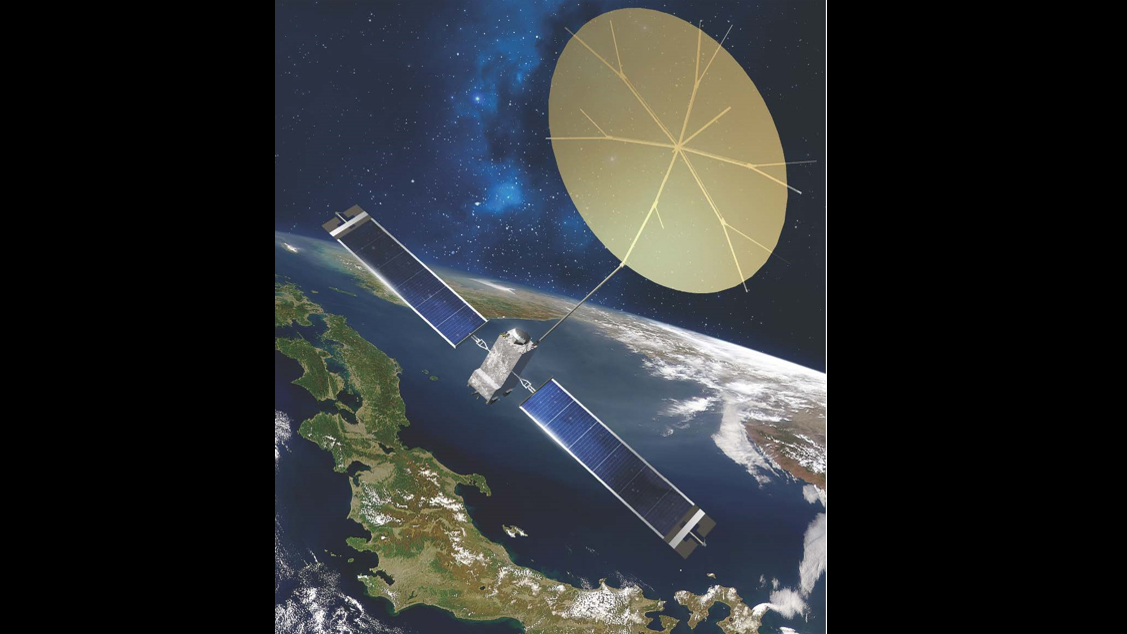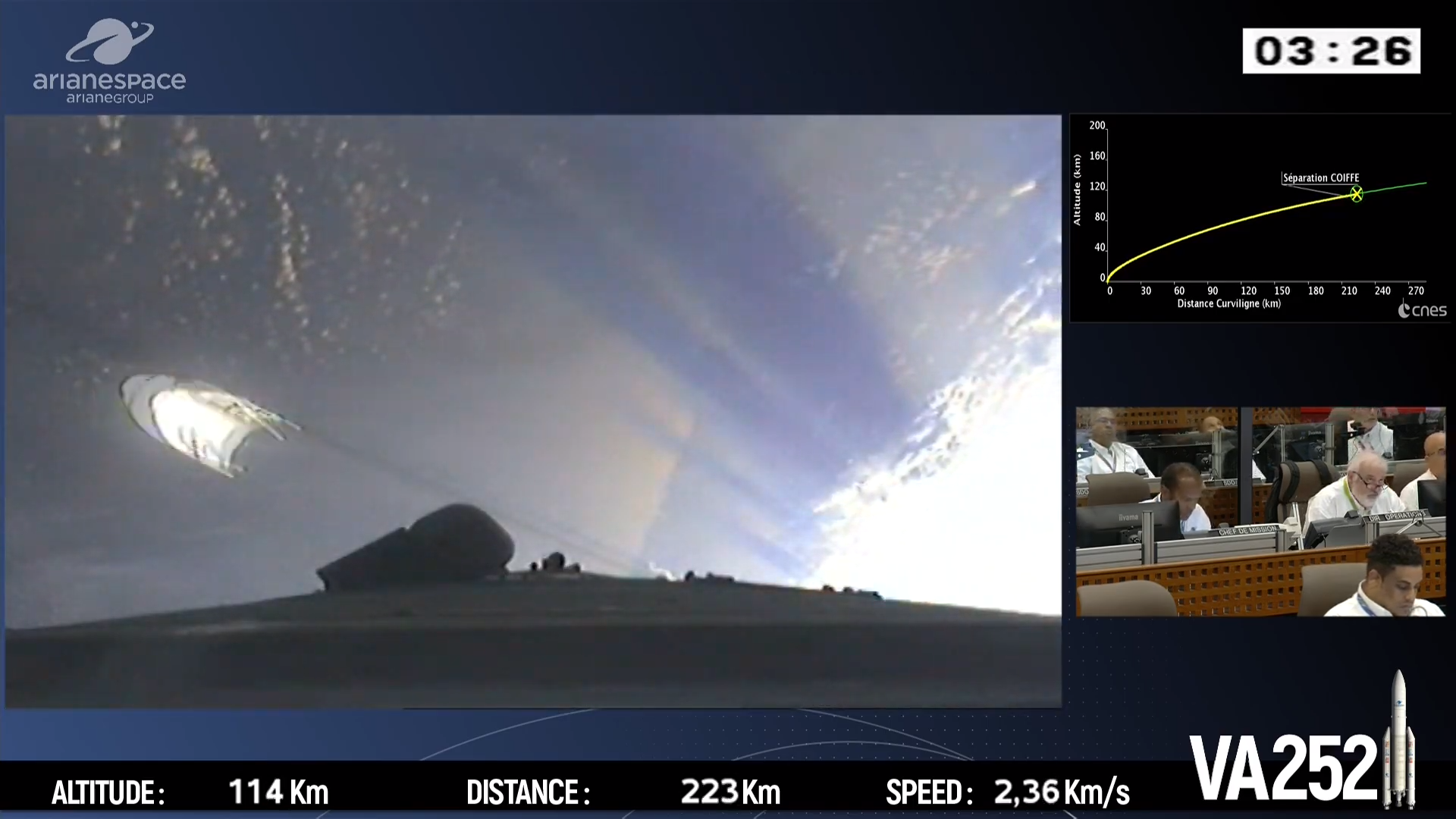Ariane 5 rocket launches satellites for Japan, South Korea into orbit
Arianespace's third flight of 2020 saw a rocket boost a Japanese telecommunications satellite and a Korean oceanography satellite into orbit from the Guiana Space Center.
The Ariane 5 rocket lifted off flawlessly into a dark sky from Kourou, French Guiana at 5:18 p.m. EST (2218 GMT or 7:18 p.m. local time). The launch continued Arianespace's relationships with entities in Japan and Korea that regularly launch satellites for civilian purposes.
"I am thrilled to announce that JCSAT-17 and GEO-Kompsat 2B have been injected as planned into their targeted orbit," Luce Fabreguettes, Arianespace's executive vice president of missions, operations and purchasing, said in a post-launch news conference, adding that the rocket performed "flawlessly."
Video: Ariane 5 rocket launches satellites for Japan and South Korea
Related: Arianespace rocket launches South Korean weather satellite

An artist's illustration of GEO-Kompsat 2B in orbit.

An artist's impression of JCSAT-17 in a geostationary orbit over Japan.

GEO-Kompsat 2B is installed atop its Ariane 5 launch vehicle.

An Ariane 5 rocket stands ready for launch.

An Ariane 5 rocket lifts off from the Guiana Space Center on Feb. 18, 2020.

The payload fairing was jettisoned after 3 minutes and 21 seconds.

A view of sunset on Earth as the Ariane 5 rocket heads to orbit.
The first of the satellites is called JCSAT-17, for the Japanese operator SKY Perfect JSAT Corporation. This satellite will be placed into geostationary orbit to provide high-bandwidth video, broadband and cellular communications services to customers in and around Japan. Among the customers served by this satellite will be NTT Docomo, the largest telecommunications company in Japan, Arianespace said in a statement.
The second satellite is called GEO-Kompsat 2B, launched on behalf of the Korea Aerospace Research Institute (KARI). This satellite is part of a Korean national program that is operating geostationary satellites for civilian purposes, Arianespace added. GEO-Kompsat 2B is optimized for Earth environment and ocean monitoring applications.
Arianespace hefted a predecessor satellite into orbit, called GEO-Kompsat 2A, in December 2018. While its sister satellite was made to monitor space weather, or the way solar particles from the sun influence magnetic activity around Earth, GEO-Kompsat 2B will focus on Earth's oceans, air quality and other meteorological factors.
Get the Space.com Newsletter
Breaking space news, the latest updates on rocket launches, skywatching events and more!
Arianespace, which turns 40 years old in 2020, is a commercial launch provider with a family of different rockets. Ariane 5 is used for heavy-lifting satellites to geostationary transfer orbit, where satellites can then proceed to geostationary orbit, where they constantly linger above the same part of the globe. Arianespace also uses the Soyuz 2 for medium-lift payloads, and Vega for smaller payloads.
Arianespace is working on successor rockets, called Ariane 6 and Vega C, which are billed as new "rideshares" to bring satellites into space.
- In photos: Ariane 5 rocket launches DirecTV 16 and Eutelsat 7C satellites
- In Photos: Ariane 5 launches Intelsat 39 and EDRS-C satellites
- Meet Ariane 6 and Vega C: Europe's new 'rideshare' rockets (videos)
Follow Elizabeth Howell on Twitter @howellspace. Follow us on Twitter @Spacedotcom and on Facebook.
OFFER: Save at least 56% with our latest magazine deal!
All About Space magazine takes you on an awe-inspiring journey through our solar system and beyond, from the amazing technology and spacecraft that enables humanity to venture into orbit, to the complexities of space science.
Join our Space Forums to keep talking space on the latest missions, night sky and more! And if you have a news tip, correction or comment, let us know at: community@space.com.

Elizabeth Howell (she/her), Ph.D., was a staff writer in the spaceflight channel between 2022 and 2024 specializing in Canadian space news. She was contributing writer for Space.com for 10 years from 2012 to 2024. Elizabeth's reporting includes multiple exclusives with the White House, leading world coverage about a lost-and-found space tomato on the International Space Station, witnessing five human spaceflight launches on two continents, flying parabolic, working inside a spacesuit, and participating in a simulated Mars mission. Her latest book, "Why Am I Taller?" (ECW Press, 2022) is co-written with astronaut Dave Williams.

